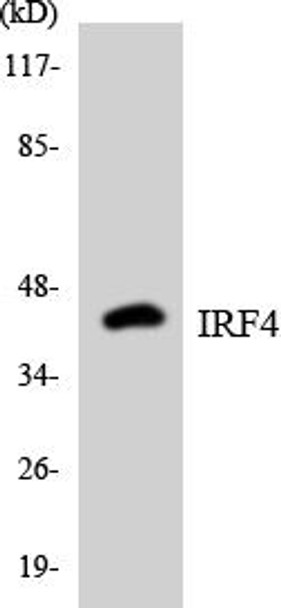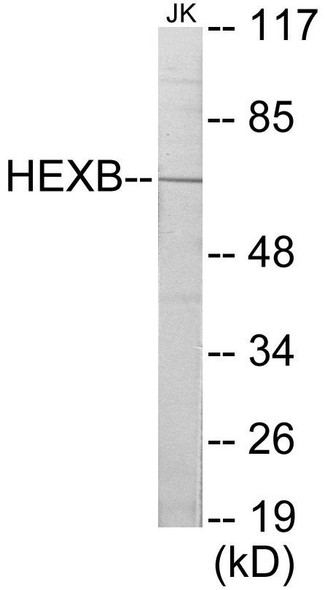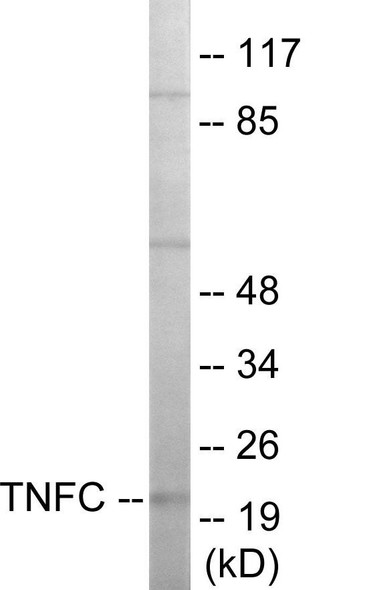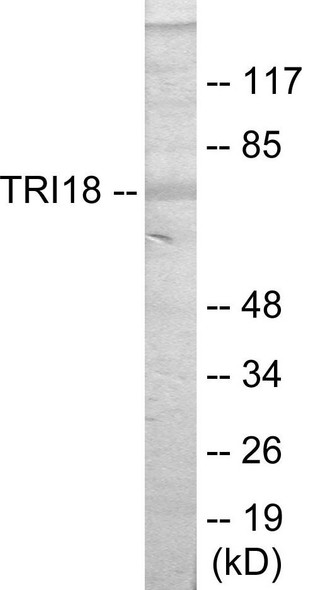Description
IRF4 Colorimetric Cell-Based ELISA
The IRF4 Colorimetric Cell-based ELISA Kit offered by Assaygenie is specifically designed for the accurate detection of IRF4 (interferon regulatory factor 4) levels in cell lysates and tissue homogenates. This kit offers high sensitivity and specificity, providing reliable and reproducible results for researchers studying immune response, inflammation, and cancer.IRF4 is a transcription factor that plays a crucial role in regulating immune responses and cell differentiation. Dysregulation of IRF4 has been linked to various autoimmune disorders, inflammatory diseases, and cancers, making it a valuable biomarker for understanding disease pathogenesis and identifying potential therapeutic targets.
With its user-friendly protocol and quick turnaround time, the IRF4 Colorimetric Cell-based ELISA Kit is an essential tool for researchers looking to explore the role of IRF4 in various biological processes and disease states. Get accurate and reliable results with Assaygenie's high-quality ELISA kit.
| Product Name: | IRF4 Colorimetric Cell-Based ELISA |
| Product Code: | CBCAB00068 |
| ELISA Type: | Cell-Based |
| Target: | IRF4 |
| Reactivity: | Human, Mouse |
| Dynamic Range: | > 5000 Cells |
| Detection Method: | Colorimetric 450 nmStorage/Stability:4°C/6 Months |
| Format: | 96-Well Microplate |
The IRF4 Colorimetric Cell-Based ELISA Kit is a convenient, lysate-free, high throughput and sensitive assay kit that can detect IRF4 protein expression profile in cells. The kit can be used for measuring the relative amounts of IRF4 in cultured cells as well as screening for the effects that various treatments, inhibitors (ie siRNA or chemicals), or activators have on IRF4.
Qualitative determination of IRF4 concentration is achieved by an indirect ELISA format. In essence, IRF4 is captured by IRF4-specific primary antibodies while the HRP-conjugated secondary antibodies bind the Fc region of the primary antibody. Through this binding, the HRP enzyme conjugated to the secondary antibody can catalyze a colorimetric reaction upon substrate addition. Due to the qualitative nature of the Cell-Based ELISA, multiple normalization methods are needed:
| 1. | A monoclonal antibody specific for human GAPDH is included to serve as an internal positive control in normalizing the target absorbance values. |
| 2. | Following the colorimetric measurement of HRP activity via substrate addition, the Crystal Violet whole-cell staining method may be used to determine cell density. After staining, the results can be analysed by normalizing the absorbance values to cell amounts, by which the plating difference can be adjusted. |
| Database Information: | Gene ID: 3662, UniProt ID: Q15306, OMIM: 254500/601900, Unigene: Hs.401013 |
| Gene Symbol: | IRF4 |
| Sub Type: | None |
| UniProt Protein Function: | IRF4: Transcriptional activator. Binds to the interferon- stimulated response element (ISRE) of the MHC class I promoter. Binds the immunoglobulin lambda light chain enhancer, together with PU.1. Probably plays a role in ISRE-targeted signal transduction mechanisms specific to lymphoid cells. Interacts with SPIB and DEF6. Not induced by interferons. Lymphoid cells. Belongs to the IRF family. 2 isoforms of the human protein are produced by alternative splicing. |
| UniProt Protein Details: | Protein type:DNA-binding; Transcription factor; Oncoprotein Chromosomal Location of Human Ortholog: 6p25-p23 Cellular Component: nucleoplasm; membrane; cytoplasm; cytosol; nucleus Molecular Function:protein binding; sequence-specific DNA binding; protein-lysine N-methyltransferase activity; transcription factor binding; transcription factor activity Biological Process: transcription, DNA-dependent; T cell activation; cytokine and chemokine mediated signaling pathway; positive regulation of interleukin-2 biosynthetic process; positive regulation of transcription, DNA-dependent; regulation of T-helper cell differentiation; myeloid dendritic cell differentiation; defense response to protozoan; peptidyl-lysine methylation; positive regulation of interleukin-10 biosynthetic process; positive regulation of interleukin-4 biosynthetic process; positive regulation of interleukin-13 biosynthetic process; negative regulation of toll-like receptor signaling pathway; positive regulation of transcription from RNA polymerase II promoter; positive regulation of DNA binding Disease: Skin/hair/eye Pigmentation, Variation In, 8 |
| NCBI Summary: | The protein encoded by this gene belongs to the IRF (interferon regulatory factor) family of transcription factors, characterized by an unique tryptophan pentad repeat DNA-binding domain. The IRFs are important in the regulation of interferons in response to infection by virus, and in the regulation of interferon-inducible genes. This family member is lymphocyte specific and negatively regulates Toll-like-receptor (TLR) signaling that is central to the activation of innate and adaptive immune systems. A chromosomal translocation involving this gene and the IgH locus, t(6;14)(p25;q32), may be a cause of multiple myeloma. Alternatively spliced transcript variants have been found for this gene. [provided by RefSeq, Aug 2010] |
| UniProt Code: | Q15306 |
| NCBI GenInfo Identifier: | 2497445 |
| NCBI Gene ID: | 3662 |
| NCBI Accession: | Q15306.1 |
| UniProt Secondary Accession: | Q15306,Q5VUI7, Q99660, |
| UniProt Related Accession: | Q15306 |
| Molecular Weight: | 451 |
| NCBI Full Name: | Interferon regulatory factor 4 |
| NCBI Synonym Full Names: | interferon regulatory factor 4 |
| NCBI Official Symbol: | IRF4 |
| NCBI Official Synonym Symbols: | MUM1; LSIRF; SHEP8; NF-EM5 |
| NCBI Protein Information: | interferon regulatory factor 4; multiple myeloma oncogene 1; lymphocyte-specific interferon regulatory factor |
| UniProt Protein Name: | Interferon regulatory factor 4 |
| UniProt Synonym Protein Names: | Lymphocyte-specific interferon regulatory factor; LSIRF; Multiple myeloma oncogene 1; NF-EM5 |
| Protein Family: | Interferon regulatory factor |
| UniProt Gene Name: | IRF4 |
| UniProt Entry Name: | IRF4_HUMAN |
| Component | Quantity |
| 96-Well Cell Culture Clear-Bottom Microplate | 2 plates |
| 10X TBS | 24 mL |
| Quenching Buffer | 24 mL |
| Blocking Buffer | 50 mL |
| 15X Wash Buffer | 50 mL |
| Primary Antibody Diluent | 12 mL |
| 100x Anti-Phospho Target Antibody | 60 µL |
| 100x Anti-Target Antibody | 60 µL |
| Anti-GAPDH Antibody | 60 µL |
| HRP-Conjugated Anti-Rabbit IgG Antibody | 12 mL |
| HRP-Conjugated Anti-Mouse IgG Antibody | 12 mL |
| SDS Solution | 12 mL |
| Stop Solution | 24 mL |
| Ready-to-Use Substrate | 12 mL |
| Crystal Violet Solution | 12 mL |
| Adhesive Plate Seals | 2 seals |
The following materials and/or equipment are NOT provided in this kit but are necessary to successfully conduct the experiment:
- Microplate reader able to measure absorbance at 450 nm and/or 595 nm for Crystal Violet Cell Staining (Optional)
- Micropipettes with capability of measuring volumes ranging from 1 µL to 1 ml
- 37% formaldehyde (Sigma Cat# F-8775) or formaldehyde from other sources
- Squirt bottle, manifold dispenser, multichannel pipette reservoir or automated microplate washer
- Graph paper or computer software capable of generating or displaying logarithmic functions
- Absorbent papers or vacuum aspirator
- Test tubes or microfuge tubes capable of storing ≥1 ml
- Poly-L-Lysine (Sigma Cat# P4832 for suspension cells)
- Orbital shaker (optional)
- Deionized or sterile water
*Note: Protocols are specific to each batch/lot. For the correct instructions please follow the protocol included in your kit.
| Step | Procedure |
| 1. | Seed 200 µL of 20,000 adherent cells in culture medium in each well of a 96-well plate. The plates included in the kit are sterile and treated for cell culture. For suspension cells and loosely attached cells, coat the plates with 100 µL of 10 µg/ml Poly-L-Lysine (not included) to each well of a 96-well plate for 30 minutes at 37°C prior to adding cells. |
| 2. | Incubate the cells for overnight at 37°C, 5% CO2. |
| 3. | Treat the cells as desired. |
| 4. | Remove the cell culture medium and rinse with 200 µL of 1x TBS, twice. |
| 5. | Fix the cells by incubating with 100 µL of Fixing Solution for 20 minutes at room temperature. The 4% formaldehyde is used for adherent cells and 8% formaldehyde is used for suspension cells and loosely attached cells. |
| 6. | Remove the Fixing Solution and wash the plate 3 times with 200 µL 1x Wash Buffer for five minutes each time with gentle shaking on the orbital shaker. The plate can be stored at 4°C for a week. |
| 7. | Add 100 µL of Quenching Buffer and incubate for 20 minutes at room temperature. |
| 8. | Wash the plate 3 times with 1x Wash Buffer for 5 minutes each time. |
| 9. | Add 200 µL of Blocking Buffer and incubate for 1 hour at room temperature. |
| 10. | Wash 3 times with 200 µL of 1x Wash Buffer for 5 minutes each time. |
| 11. | Add 50 µL of 1x primary antibodies (Anti-IRF4 Antibody and/or Anti-GAPDH Antibody) to the corresponding wells, cover with Parafilm and incubate for 16 hours (overnight) at 4°C. If the target expression is known to be high, incubate for 2 hours at room temperature. |
| 12. | Wash 3 times with 200 µL of 1x Wash Buffer for 5 minutes each time. |
| 13. | Add 50 µL of 1x secondary antibodies (HRP-Conjugated AntiRabbit IgG Antibody or HRP-Conjugated Anti-Mouse IgG Antibody) to corresponding wells and incubate for 1.5 hours at room temperature. |
| 14. | Wash 3 times with 200 µL of 1x Wash Buffer for 5 minutes each time. |
| 15. | Add 50 µL of Ready-to-Use Substrate to each well and incubate for 30 minutes at room temperature in the dark. |
| 16. | Add 50 µL of Stop Solution to each well and read OD at 450 nm immediately using the microplate reader. |
(Additional Crystal Violet staining may be performed if desired – details of this may be found in the kit technical manual.)






